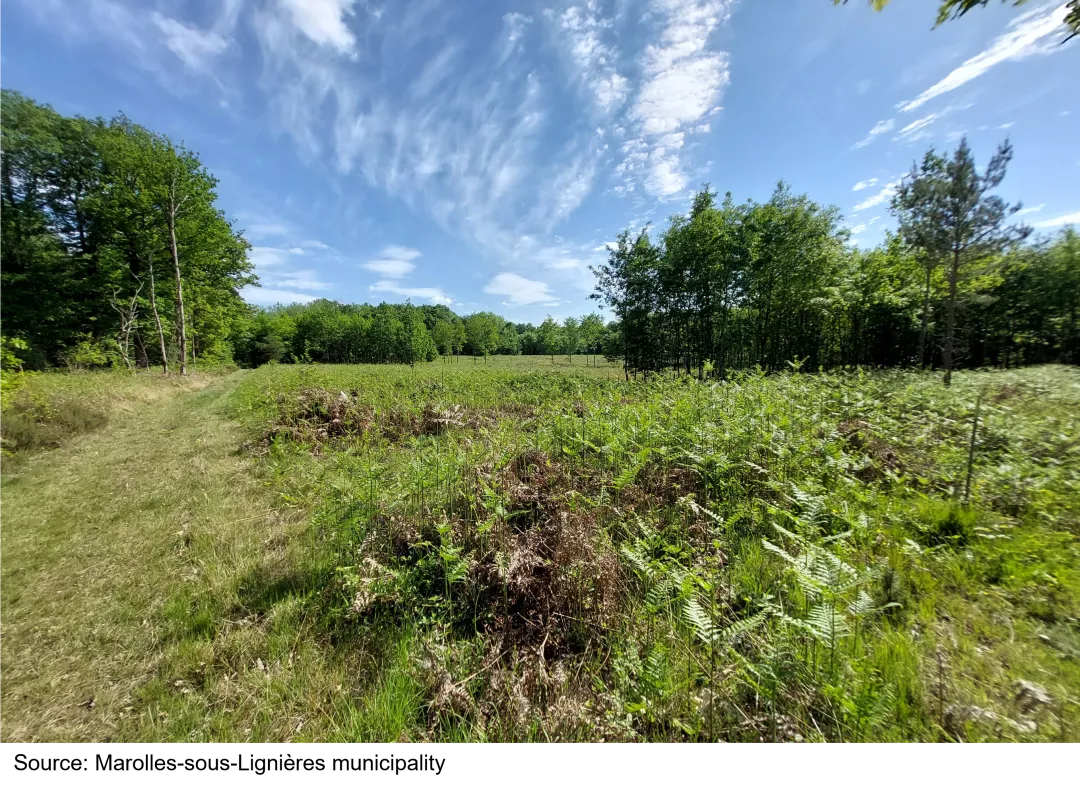General information
RDP Priority
- P4. Ecosystems management
RDP Focus Area
- 4A: Biodiversity restoration, preservation & enhancement
RDP Measure
- M08: Investments in forest areas
Summary
In 2015, the municipal forest of Marolles-sous-Lignières in the region of Champagne-Ardenne, France suffered from a fire that destroyed 27 hectares of its surface. Following the fire, five hectares were totally burned and did not recover. A study was commissioned to identify those plants that would be able to cope with the situation so that the area could be re-developed as a forest with its respective ecosystem. Two species were identified by the study as suitable (sessile oak and pine). Working in partnership with the National Forest Office (ONF), the municipality decided to develop a re-forestation project. The objective was to recover the five hectares of forest and plant species which could develop successfully in the long term. More than 4 000 oak and 1 000 pine trees were planted. In 2021, a study found that the newly planted forest benefited from a recovery rate of 78%.
Results
The following results were obtained:
- One diagnosis was produced for forest plots affected by the fire to define reforestation targeting.
- 4 344 sessile oaks and 1 860 pines were planted after clearing the area of ferns.
- A field survey was conducted in 2021 demonstrating that the five hectares replanted have a recovery rate of 78%.
Promoter
Marolles-sous-Lignières municipality
Funding
Total budget 22 645 (EUR)
EAFRD 4 800 (EUR)
National/Regional 17 845 (EUR)
Ressources
Documents
EU CAP Network - Good Practice - Reforestation of a burned forest area near Marolles-sous-Lignières municipality
(PDF – 581.77 Ko)
Context
In 2015, a fire burned 27 hectares of forest plots near the Marolles-sous-Lignières municipality in the region of Champagne-Ardenne, France. The mayor was keen to proceed with the reforestation of the communal forest in partnership with the national forest authorities. However, of all the burned plots, five hectares could not grow back, and their natural regeneration was challenging. To explore the reasons for this, a study was carried out identifying those plant species that could cope with the badly affected areas and help re-develop the forest ecosystem. In 2016, the municipality initiated a reforestation exercise to ensure the preservation and sustainability of the forest in the long term. It was agreed to replant two species of trees on the five-hectare plot, including sessile oaks and pines, to guarantee the rehabilitation of an appropriate level of biodiversity. Subsequently, a project plan was developed in partnership with the National Forest Office (ONF – Office National des Forêts). The involvement of the ONF brought expertise and knowhow that was most beneficial also during project implementation.
Objectives
The project had several objectives:
- The reforestation of five hectares of forest by replanting trees in an area deeply affected by the fire and where vegetation could not grow back by itself.
- The procurement and planting of sessile oak and pine trees that can withstand the specificities of the soil (sandy) and the climate (with regular droughts during the summer).
- The reconstitution and maintenance of the forest ecosystems affected by the fire.
- The monitoring of the development and growth of these plantations to ensure forest repopulation in the long term.
Activities
Reforestation activities included:
- A diagnosis of the effects of the fire (2016): a pre-reforestation diagnosis was conducted on the plots. This observation helped to define which plants were growing back and which plots were the most affected by the fire.
- Fern management and removal (2016): ferns had grown back on the burned plots. Fern develops very quickly and grows rapidly, which does not allow the development of other plants. It was thus necessary to proceed with their uprooting to plant viable and more diversified species.
- The development of a silvicultural itinerary and the tree replanting process (2018-2019): Experts from ONF carried out an analysis of the five-hectare plot to define the best planting methods (such as the distance between plants, number of planting lines, etc.).
- The replanting of sessile oaks and pines was carried out in 2020 using RDP support. This activity was guided by ONF experts to guarantee the plants’ growth.
Main results
The following results were obtained:
- One diagnosis was produced regarding the forest plots affected by the fire to define which part of the forest should be reforested.
- 4 344 sessile oaks and 1 860 pines were planted after clearing the area of ferns.
- A field survey was conducted in 2021 demonstrating that the five hectares replanted have a recovery rate of 78%.
Key lessons and recommendations
- The removal of the ferns when preparing the site proved to be more difficult than expected. Fern has very deep rhizomes and digging them out was not effective. It became necessary to beat the ferns (meaning to beat the fern with a machine on its upper part where the plant produces new leaves). This step took longer than expected.
- Damage by natural pests and wildlife reduced the growth rate of the plants. Several young oak and pine trees were eaten by Roe deer. At the same time, the oaks attracted processionary moth caterpillar pests. ONF experts applied a specific repellent on the shoots to minimise further damage.
- Further climate challenges threaten the development of the plants. The region is experiencing a growing drought phenomenon. It is therefore difficult to guarantee the growth of the planted trees in the long term due to the growing threat of water shortage.
“The idea was to enhance the development of biodiversity and ensure the continuous preservation of our forests. As the effects of climate change increase, forest protection should be a key priority in rural territories.”
Marolles-sous-Lignières municipality
